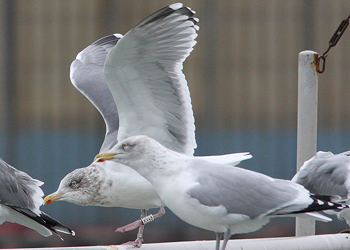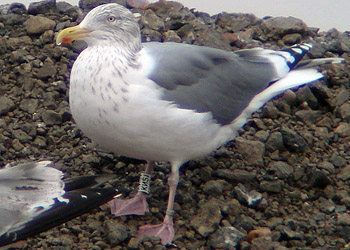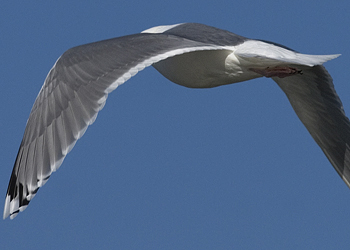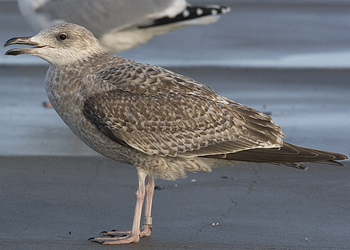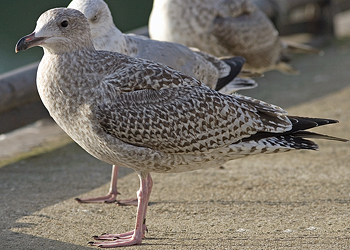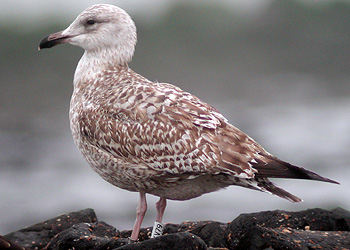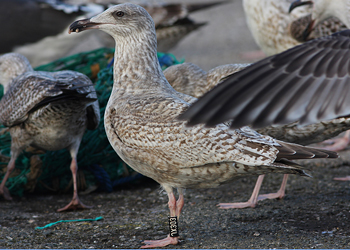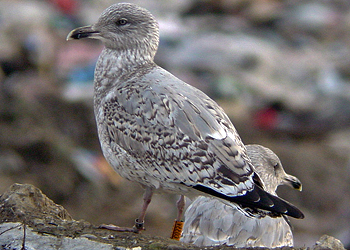 Herring Gull- Zilvermeeuw (argentatus & argenteus)
Herring Gull- Zilvermeeuw (argentatus & argenteus)
(last update: April 07, 2014
Herring Gull - 4cy & 5cy (sub-adults) February
Yellow-legged gulls and yellow-legged Herring Gulls in the Baltic
LARS JONSSON - Alula 3/1998
 This is a copy of the article "Yellow-legged gulls and yellow-legged Herring Gulls in the Baltic", by Lars Jonsson and published in Alula 3, 1998. "I" in the text refer to the author Jonsson. We also reproduced some tables and figures from this article, but also added many, many more images from especially ringed birds to illustrate Lars's article. We did our best to be very precise, but if you find any errors, please let me know at marsmuusse at gmail dot com.
This is a copy of the article "Yellow-legged gulls and yellow-legged Herring Gulls in the Baltic", by Lars Jonsson and published in Alula 3, 1998. "I" in the text refer to the author Jonsson. We also reproduced some tables and figures from this article, but also added many, many more images from especially ringed birds to illustrate Lars's article. We did our best to be very precise, but if you find any errors, please let me know at marsmuusse at gmail dot com.
PART 1: Taxonomy & Nomenclature
below: PART 2: Field identification
Yellow-legged gulls and yellow-legged Herring Gulls in the Baltic
LARS JONSSON - Alula 3/1998
Mantle colour
It is necessary to say something about evaluating the mantle colour. The term mantle colour refers to all the grey feathers on the upperparts of adult large gulls, e.g. mantle, scapulars, wing coverts and the basal part of the wing feathers and not only to the mantle. I personally think that the human eye is a very sensitive instrument. Very fine differences in the shades of mantle colours can be detected and evaluated in the field by making direct comparison amongst groups of resting gulls. However, such evaluations in the field are difficult or almost impossible to use in making comparisons between data from different observers. The most reliable and maybe scientific approach is probably an optical measuring of the reflection values, resulting in Munsell-notations as executed and described by Barth (1966). More frequently, colour charts are used for matching colours against a specimen. This method involves a personal judgement and must be done with great care, but will produce data which can be more easily compared between different studies. Both the two standard references for colours used by naturalists, Ridgeways Color standards and color nomenclature 1912 and Smith's Colorguide for Naturalists 1975 are expensive and difficult to obtain.
My basic method is using the Kodak Color Separation Guide and Grey Scale (large) Cat 152 7662 1995. It (the Grey Scale) does not give any colour hue or chroma and runs on a scale between 0 (white) to 20 (black). All comparisons and mean values given below, as measured on specimens, refer to this scale. The chart was placed flat over the middle of one of the scapular feathers tracts and thereafter held at different angles and in varying light before a final decision was reached. One or several feathers were also lifted up and placed on the Grey Scale, where after the scale was drawn back and forth to see which shade the feather was best concealed against. Compared to the other scales nr. 5 on the Kodak Grey Scale represent a Munsell-value of around 6.0 which is Light Neutral Grey according to Smith's Color guide and Kodak nr. 7 represent Munsell 5.0 and Medium Neutral Grey in Smiths. In Munsell notations darker shades are equivalent to a smaller Munsell value. If the feather tone falls clearly between two neighbouring shades, for instance 5 and 6, I write it down as 5/6 which is entered as 5.5. Sometimes I find it very close to, for instance shade 6, but if it's either slightly darker (6+) or slightly lighter (6-) I will enter the values 6.25 and 5.75 respectively when calculating mean values. The method however does not actually allow a measurement of decimal values. A mean value of for instance, 5.6 basically indicates that the typical shade falls between Light and Medium Neutral Grey.
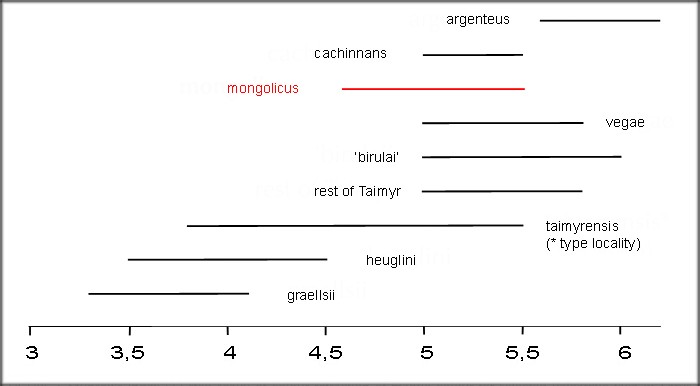
FIGURE Z Munsell’s index (37-step scale) of colour refraction of mantle colour for selected Palearctic taxa of Larus argentatus-cachinnans-fuscus complex. Darkness of grey mantle decreases from left to right. Only specimens of range given in type description, ie, lower reaches of Yenisei river in south-western Taimyr, have been included in Taimyr Gull L. (heuglini) taimyrensis. Specimens used for Birula Gull L. vegae birulai came from western Yakutia and east to Kolyma delta, those for Vega Gull L. vegae from east of Kolyma river to Chukchi peninsula. Argenteus, not representing a valid subspecies according to Dutch committee for avian systematics (CSNA) (Sangster et al 1999), refers to western and paler population of Herring Gull L. argentatus. Data from Barth (1966) and by courtesy of Andrey Filchagov (in litt) and Sergey Pyzhianov (in litt).

The average darkness of the grey on the mantle of a large gull is linked to the amount of sun rays in its wintering area (Jonsson in prep.). Within a population which has historically shared migratory habits a close similarity in the mantle shade is expected. Therefore, the darkness of an individual bird will most likely reveal its origin/subspecific identity. Measuring the exact value of one single individual in the field and using this as a means of identification is difficult. In collections, or in the hand, it is a useful instrument, however.
Timing of primary moult
The timing of the primary moult differs to some degree between different species and also between populations of one particular species. The onset of the moult is probably dependent on an inherited time-programme which to a certain extent may be modified by external and internal factors (Streseman 1971). The differences in timing of the average onset of primary moult between the various populations of argentatus, cachinnans and michahellis seem to be less than possibly expected. For all species, the onset of the moult seems to fall within the span of less than one month, from mid May to mid June for all species. My personal experience from Gotland and the Baltic Sea is that the difference between cachinnans and argentatus is slight and seldom conclusive, yet it is worth recording. The situation might be as in the following example from October 20th when one adult cachinnans showed four visible primary tips beyond the tertials (P9 had grown beyond P8) whereas only one or two out of one hundred argentatus was this advanced. The difference between argentatus and michahellis should be greater but I do not have enough material from the Baltic area to be able to evaluate the importance of this as a field mark. Michahellis from south-eastern Europe possibly moults somewhat later than those from the western Mediterranean, which could result in the situation in the Baltic being slightly different from that of western Europe. During a visit to Hungary, on the 24th July, I recorded the number of unshed primaries on 15 adult michahellis (table 1). A week later, on the 30th July, I repeated this with a flock of 59 argentatus on Gotland. Allowing for the interval of six days, I estimated that Baltic argentatus moult between one to two weeks later than michahellis from the eastern Mediterranean.
| Table I | michahellis, Hungary, 24 July | argentatus, Gotland, 30 July | ||
| no. of retained primaries | n | % | n | % |
| 6 | 0 | 0 | 1 | 2 |
| 5 | 2 | 13 | 19 | 32 |
| 4 | 9 | 60 | 37 | 63 |
| 3 | 3 | 20 | 1 | 2 |
| 2 | 1 | 7 | 1 | 2 |
| Adult michahellis remaining old primaries, July 11 2002 Etaples, NW France. n = 66, m = 6.3, SD = 1.03 | |
| P4 / <P5 old | 4 |
| P5 old | 7 |
| P6 old | 29 |
| P7 old | 19 |
| P8 old | 6 |
| P9 old | 1 |
| P4 / <P5 old: at least P5-P10 are still old and these scores are added by the definite P4-P10 birds. Those <P5 birds refer to sleeping adults. | |
| adult michahellis remaining old and fully grown new primaries, July 28 2001 Etaples. | ||||||
| p? | p3 new | p4 new | p5 new | p6 new | n = | |
| p6 old | 1 | 1 | ||||
| p7 old | 14 | 2 | 4 | 20 | ||
| p8 old | 14 | 3 | 5 | 4* | 26 | |
| p9 old | 1 | 1 | 2 | |||
| p10 old | 1 | 1 | ||||
m (average): 2.4 remaining old primaries, SD = 0.69 |
||||||
| adult michahellis remaining old and fully grown new primaries, July 29 2001 Etaples. | ||||||
| ? | p2 new | p3 new | p4 new | p5 new | n = | |
| p7 old | 16 | 1 | 2 | 3* | 22 | |
| p8 old | 20 | 8** | 3*** | 31 | ||
| p9 old | 2 | 1 | 3 | |||
m (average) = 2.3 remaining old primaries; SD (standard deviation value) = 0.58. |
||||||
Field identification
In most cases it is possible to identify argentatus, cachinnans and michahellis in the field. The difficulties and the complexity of shared characters is however not to be underestimated. A serious study of large numbers of Herring Gulls will produce many look-alikes, which at times may be quite exasperating. Some immature argentatus can look astonishingly like michahellis and it is only through considerable experience that some of them can be confidently identified. I have also seen several gulls which seem to fall in between argentatus and cachinnans in their characters. Such individuals, very few in numbers, do not detract from the fact that many distinct Caspian Gulls do occur, and can be readily identified. We must also take into account that hybrids may occur. This has been proven for graellsii x michahellis, argentatus x michahellis as well as fuscus x argentatus, which makes it very likely that hybrids between any two taxa may occasionally occur.
As in most cases concerning the identification of similar and closely related birds, the circumstances might make the outcome different from one day to another. I have had days with several straightforward cachinnans and a week later I instead find three birds which I simply cannot identify. Of course the more intensely one studies gulls, the more odd individuals will show up. Also keep in mind that in Britain and Ireland some of the sharpest gull enthusiasts repeatedly have problems separating some juvenile graellsii from argenteus and michahellis - not because they lack experience or skill - but because the forms can look so similar. In addition, juvenile Great Black-backed Gulls occasionally give me a headache, which is frustrating, as we all know that they are easy to tell from argentatus, or are they?
The basic conditions are such that by looking through a great number of argentatus you will sooner or later pick out some birds with characters of michahellis or cachinnans. The next step has to be to look for other characters. If they do not support the initial supposition one simply has to give up on that particular bird. If another two or three characters add to the picture you are looking at something worth spending time on, All details can be of importance and make a rule of constantly comparing the observed features with those of accompanying argentatus or fuscus. It is easy to interpret small differences which fall within the normal range of variation as indicative of the rare bird if you get excited by a long and slender-billed Herring Gull.
Herrlng Gull L. argentatus (Pontoppidan 1763)
As a starting point it is important to understand the variation within our own Herring Gull. For instance there is obviously some confusion as to what morphological characters are conclusive for cachinnans. This problem was discussed earlier in Alula (Hario 1997).
The nominate argentatus inhabits the whole of Fennoscandia countries surrounding the Baltic Sea. It was originally described from Denmark, most likely the island of Christianso in the southernmost Baltic Sea. Its distribution, and in particular its population size, have changed changes dramatically during this century. Rather recently, during the last one or two decades, new inland wetlands (especially man-made reservoirs) have been colonised in Germany, Poland and Russia, east to at least Nishni Novgorod (Filchagov pers. comm./in litt). The mantle shade of argentatus within Fennoscandia varies from Kodak 5.0 to 7.0, thus spanning the whole range of shades shown by the palest cachinnans to the darkest michahellis. Geographical variation will be discussed in further detail below.
Argenteus occupies Britain, Ireland, Iceland and the Atlantic/North Sea coast of continental Europe north south-western Denmark. It is on average paler and smaller (wing and bill) than argentatus with a typical mantle shade of Kodak 5.0-5.5.
A certain amount of intermediates between these two subspecies occur along the coast of the North Sea, especially in Denmark (Barth 1968).
Herring Gulls L. argentatus (major/omissus) with yellow legs
There are Herring Gulls in the Baltic region with specific features worth keeping in mind when discussing the identification of cachinnans and michahellis. The yellow-legged element, usually referred to as Yellow-legged Herring Gulls, or omissus, is a widely discussed subject among gull taxonomists, on which I can not resist giving some personal views. In the following discussion I basically refer to the statistic material presented by Barth 1968 & 1975, Kilpi & Hario 1968, Mierauskas 1991, Greimas & Buzun 1991, Hario 1997 and my own material from specimen collections, as well as field studies from Gotland and other areas of Europe.
From Barth's work we can conclude that yellow-legged individuals are present throughout the whole of Scandinavia. They are however much more common at certain localities than others and there is a south-west (grey-pink) and north-east or east-north-east (yellow) cline. We still do not have a solution as to why some argentatus have yellow legs and others not, but it may simply be diet-related. The yellow element among Herring Gulls seems to be more common in areas with a predominating fresh or brackish water habitat. In the Baltic Sea, with its brackish water, anything from 10-75 % of the population in the breeding colonies were recorded as having more or less yellowish legs. It may be that yellow legs did predominate in the past at inland localities in the Balticum, parts of Finland and north-west Russia (Kumari 1978). At Lake Saimaa in Finland 100% showed yellowish legs in samples dating back to the l950’s (Barth 1968) and at the Teichu raised peat bogs in Latvia yellow-legged birds still constituted two-thirds of the population in samples from 1987-90 (Mierauskas et al. 1991). The yellow (as well as orange and red) colour is caused by carotenoids and Lonnberg (1933) found such substances in Herring Gulls with pink legs as well. However it seems reasonable to assume that there is an element of genetic inheritance for developing yellow legs which are stronger in these areas. The percentage of birds with yellow legs within a colony also varies between different years (Hario 1997). It is quite possible that the leg colour can shift back and forth on one individual, as this happens in Common Gull Larus canus (Rattiste pers. comm.). It is also well known that the colour of the legs, bill, and orbital ring changes with age and season. Mierauskas et al. (1991) have shown that:
1) The Herring Gulls breeding on peat bogs in Latvia (Teichu) show some differences from the coastal breeding birds (St Petersburg) in having a longer bill, longer wing, longer tarsus and middle toe.
2) Studies of vocalisation and behaviour (and wingtip pattern) have not, so far, upheld the theory that the Baltic yellow-legged gulls are related, closely or distantly, to cachinnans from the Aralo-Caspian area. On the contrary, the results support a treatment of cachinnans and argentatus as separate species.
What is omissus?
The results by Mierauskas et al. (1991) have given fuel to the eternal debate whether omissus should be regarded as a valid race of L. argentatus or not. Are these Latvian, predominately yel1ow-legged gulls a remnant of an original eastern Baltic population which should be called omissus, rather than argentatus? The material from the Latvian peat bogs supports the existence of a different inland population as opposed to the coastal breeding gulls. I'm not so sure however that the name omissus is appropriate when discussing these inland populations specifically. The name has been misinterpreted or misused by several authors. Today most people specifically associate the name with yellow-legged individuals of Herring Gulls in eastern Fennoscandia, and that's basically the way it is used among field omithologists, It was first tentatively suggested by Pleske who referred to ongoing research by Suschkin (P1eske 1928). The only description published by Pleske was as follows: larger dimensions, darker mantle and different shape in the white pattern on the first primary; the legs of this subspecies are sometimes flesh-coloured, sometimes yellow. He failed to describe how the white pattern on the first primary actually differs, but I assume that he was referring to a full white tip of P10(?). The range cited by Pleske includes Gulf of` Finland, the White Sea and the Murman coast while the Solovetzkiy Islands are specifically mentioned (which is not an inland locality). Mierauskas et al. (1991) wrote According to Pleske yel1ow-legged Herring Gulls breed from the Gulf of Bothnia to the White Sea (Murman coast is not mentioned) and also quoted Pleske regarding the leg colour with the words sometimes with yellow, sometimes with greyish legs, which is quite different from the exact wording as cited above. The precise meaning of flesh-coloured is open to discussion but it must be assumed to involve some pink tone in the grey. Kumari (1978) refers to Sushkin and Pleske as well, stating that the legs of this subspecies (omissus) are yellow and the orbital ring is cinnabar (= brilliant red). Most authors have focused more on the yellow legs than on the other characteristics given by Pleske.
The intention of Sushkin (as interpreted by Pleske) was however not to distinguish a specifically yellow-legged subspecies. He looked upon argentatus from southern Scandinavia and argenteus from Britain as a single group, calling them argentatus. It seems that Sushkin's actual intention was to define the larger and darker Herring Gulls in the north-east which showed more white at the tip to P10, and which sometimes had yellow legs. This was also the view expressed by Barth. In Svenska faglar Lonnberg (1929) discussed yellow-legged Herring Gulls; he refers to a letter from Sushkin saying that he (Sushkin) believes that a Herring Gull exits on the Arctic coasts of Russia which to a certain extent looks like, but is not identical to cachinnans. Stegmann, who assisted Sushkin at the time and continued his work, preferred to regard omissus as a synonym for argentatus (Stegmann 1934 and 1960). I have not seen any statistics regarding the leg colour of the White Sea population but Stegmann (1960) wrote that the population along the coasts of northern Norway and Kola peninsula have flesh-coloured legs and earlier he stated that birds from Ladoga and the White Sea apparently always have pale yellowish legs (Stegmann 1934). Mierauskas et al. (1991) stated that in the Onega-Ladoga Lake district pink-legged gulls dominate. The percentage of birds with yellow legs may fluctuate. The sometimes predominant yellow-legged element described from inland sites in Latvia only partly fits with the phenotype that Pleske/Sushkin were about to name omissus. Perhaps individuals such as the one depicted in fig. 10, from Varanger in Finnmark, represents the original omissus? The yellow-legged individuals I see in the Baltic are somewhat variable but mostly quite different from this type. The Baltic birds have a paler grey shade to the mantle, a longer primary projection and individuals with some black on P5 are in majority. There are obviously two different phenotypes involved in the omissus discussion. Their respective characteristics originate from two different morphological centres. One is in the Norwegian Finnmark, where the birds are characterised by darker grey mantles, less black on the wingtip (no black, or very little, on P5) and, predominately, a clean white tip to P10. These birds mostly migrate westwards along the Norwegian coast. The other morphological centre is in the east Baltic/southern Finland, where birds are the largest and especially long-winged, usually show black on P5, have a strong tendency to develop yellow legs and are rather light-mantled. Another difference between these two populations is that the Barents Sea birds usually have a small and narrow grey tongue on the inner web of P10 whereas the Baltic birds sometimes have a more extensive and lighter tongue. This holds especially true for birds with a tendency to a thayeri-patterned wing, where the white eats into the darker areas (see plate C1).
Kleinschmidt (1939) discussed some very large Herring Gulls which occurred at Ribachy (Rositten, north of Kalingrad). According to him, these were very long-winged and pale and he calls them Larus argentatus major with reference to Laroides major (Brehm 1830 or 1831, according to Kleinschmidt 1939 1831 author’s note). He stated that these birds should not be lumped with omissus as they are rather pale and only partly yellow-footed and that according to ringing recoveries, the breeding grounds for major lies between the south-eastern Baltic and the White Sea. I do not know whether birds in the colonies around the White Sea show a mixture of characters between these two phenotypes (as found in Finnmark and Latvia), or whether they all belong to populations spreading from the Baltic area. If the latter is the case, the name omissus should be substituted with major (Kleinschmidt 1939).
Description
The Herring Gulls with yellow (and pinkish or grey) legs which I observe on Gotland in Sweden are slightly darker than argenteus. Ten Herring Gulls collected from inland sites in Finland (prior to 1960) had an average shade of 5.6. 19 birds collected from Gotland during the breeding season had exactly the same average value (5.6). Compared to argentatus from northern Norway, they have a paler mantle, a rather long wing (primary projection), some tend to show a proportionally longer (boat-shaped) body and black is usually found on the six outermost primaries, P5-P10 (78 % in southern Finland according to Hario 1997 n=l76, 91% on Gotland n=23). Although some birds from the Barents Sea have some black on P5 (17-39%, Barth 1968) the amount of black is reduced, so the impression is that basically all birds lack black on P5. I have looked at photographs of 30 birds from Varanger and the Murman Bay and of these, 70% lack dark on P5 (category 1; Goethe 1961), and 17% have very little (category 2). A few even lack black on P6, leaving only the 4 outermost primaries with black. Sometimes the Baltic ones show a long very pale (almost whitish) tongue on the innerweb of P10 (fig. 7), which is a pattern associated with cachinnans (plate C2). According to Mierauskas, 30% of the Latvian inland birds showed a thayeri-pattem (to P9), compared to 10% of birds from the Gulf of Finland coast. On a thayeri-patterned bird it looks as if the white areas have burned out by the black. The white margins between the grey and the black are swollen on thayeri-patterned morphs, which also impart a cachinnans-look to the wing. Often the white has eaten away the black bar/pattern on P5 as well. The pattern on the exposed P10 on the sitting birds (far wing) can be very similar to that shown by cachinnans.
The amount of dark streaks or blotches on the head in winter is very variable. The Baltic birds can occasionally have as little as typical michahellis but usually they have a distinctively dark-streaked head and neck in mid autumn (October-November). A smaller percentage has a very faintly streaked head and can be totally white-headed in early January (exceptionally earlier).
A variable percentage show yellow legs. On Gotland the numbers vary a lot but the yellow-1egged morph is most dominant during spring and especially in late March-April. In 1997 on southern Gotland up to 40% of the Herring Gulls eating earthworms on ploughed fields had distinctly yellow legs (see fig. 8 and cf. Hario 1997). Many of the yellow-legged birds had later disappeared; by mid May only about 10-15% showed yellowish legs and feet. It is important to note that some Herring Gulls in the Baltic can have long yellow legs, a full white tip to P10 as well as an almost white inner web to P10, black on six primaries and look very long-winged. These birds superficially resemble cachinnans, but I have been very rarely tempted to identify them as cachinnans, as they all have the same jizz as the accompanying pink-legged argentatus, and usually the bill does not have the shape of a typical cachinnans. When comparing the shapes of the bill between cachinnans and Baltic argentatus, the bill index (bill length/bill height at gonys) provides some comparative data. Of 35 Baltic/Finnish argentatus 86% had an index below 3.2 whereas for 18 cachinnans 72% had an index 3.2 or higher. No cachinnans had an index value under 3.0 whereas for 60% of the argentatus it was less than 3.0.
Ageing Herring Gulls
It is of course important to take a specific bird’s age into account when evaluating plumage details. The following is a very schematic outline of the ageing criteria of argentatus (in the Baltic). This is, however, based on field studies and not on birds of known age.
- Juvenile - first-winter plumage. All wing coverts are of juvenile type without any sign of moult until mid spring of the second calendar year. Primaries pointed (see fig. below).
- Second-winter plumage. The new primaries are dark brown with slightly more rounded tips. The primaries exposed beyond the tertials (P6 and outwards) show only a light rim or very small spot. The wing coverts are never uniformly grey (i.e. lacking dark marks), and this is valid throughout the winter. P10 normally lacks a mirror, but may rarely show a small off-white one (see fig. below).
- Third-winter plumage. The new inner primaries are greyer and the outer ones blacker. The exposed P6 and P7 show small to large white tips. The greater wing coverts still show brown vermiculations, while the median wing coverts are often pure grey. P10 shows a small to marked white mirror. Birds in this plumage are especially susceptible of being mistaken for second-winter cachinnans or michahellis.
- Fourth-winter plumage. Only few remnants of dark marks are found on the primary coverts and sometimes on the tail and possibly more dark on bill. Third- and fourth-winter birds may overlap in characters.
below are several unringed sub-adult birds, either Scandinavian argentatus or local continental argenteus at Katwijk beach, the Netherlands.
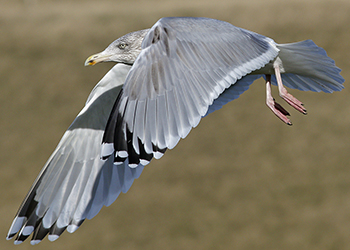 |
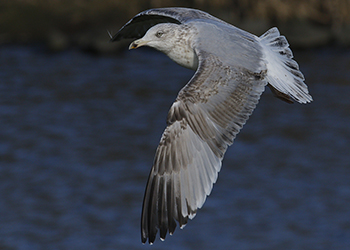 |
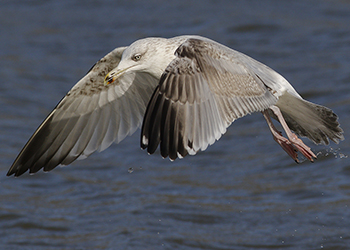 |
 |
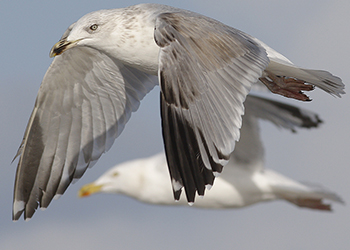 |
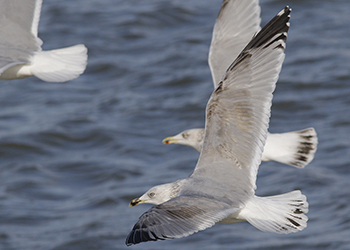 |
 |
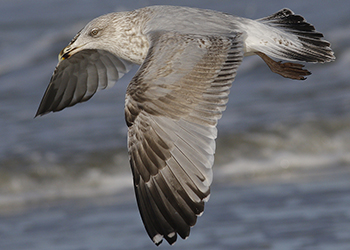 |
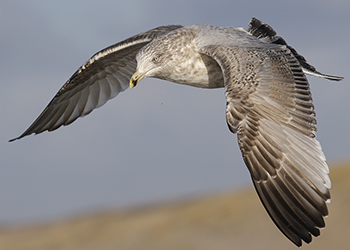 |
 |
 |
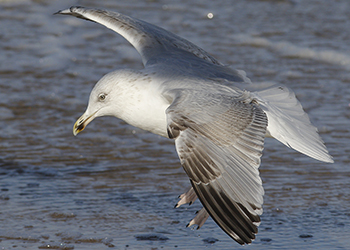 |
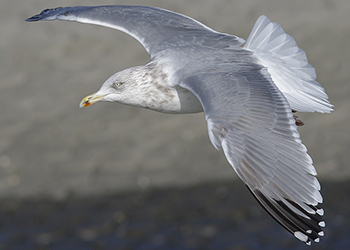 |
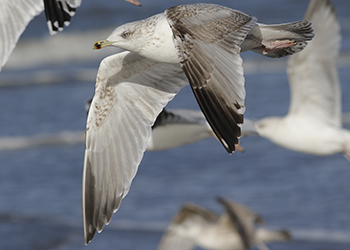 |
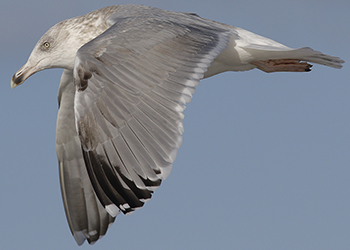 |
 |
 |
 |
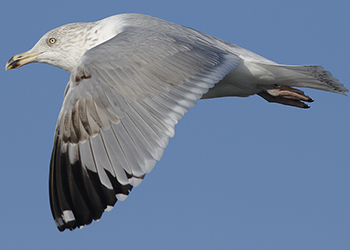 |
 |
 |
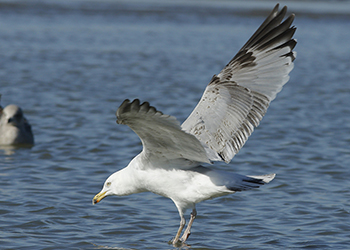 |
 |
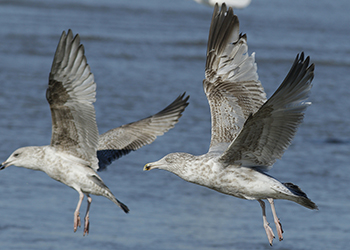 |
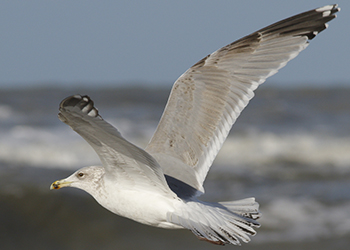 |
 |
 |
 |
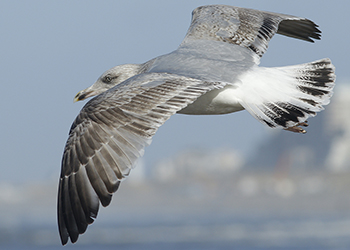 |
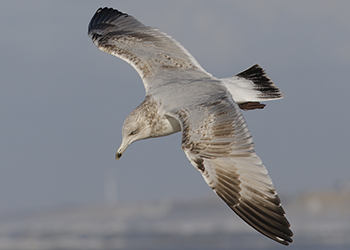 |
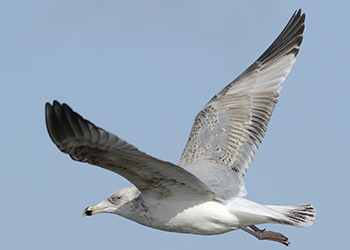 |
 |
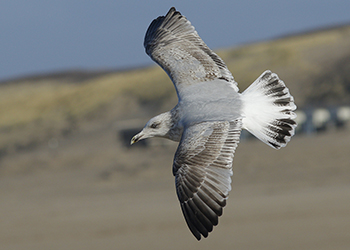 |
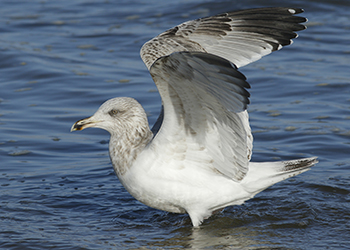 |
 Herring
Gull A3CV 4cy (argenteus), February 26 2008, Boulogne/Mer, France. Pictures J-M Sauvage.
Herring
Gull A3CV 4cy (argenteus), February 26 2008, Boulogne/Mer, France. Pictures J-M Sauvage. Herring Gull 4CY DX8TFebruary 09 2014, Katwijk, the Netherlands. Picture: Mars Muusse.
Herring Gull 4CY DX8TFebruary 09 2014, Katwijk, the Netherlands. Picture: Mars Muusse. Herring
Gull ZTA 4cy (argenteus), February 05 2012,Boulogne/Mer, France (50.42N,1.34E). Picture: J-M Sauvage.
Herring
Gull ZTA 4cy (argenteus), February 05 2012,Boulogne/Mer, France (50.42N,1.34E). Picture: J-M Sauvage. Herring
Gull AXAZ 4cy (argenteus), February 2002, Port of Calais,
northern France (50,41N
1,35E). Picture by Jean-Pierre
Leys.
Herring
Gull AXAZ 4cy (argenteus), February 2002, Port of Calais,
northern France (50,41N
1,35E). Picture by Jean-Pierre
Leys. Herring Gull argenteus BLB H-902828 4CY, February 2014, Barneveld, the Netherlands. Picture: Merijn Loeve.
Herring Gull argenteus BLB H-902828 4CY, February 2014, Barneveld, the Netherlands. Picture: Merijn Loeve.  Herring
Gull H-132449 4cy (argenteus), February 23 2007, Oostende, Belgium. Picture Ies Meulmeester.
Herring
Gull H-132449 4cy (argenteus), February 23 2007, Oostende, Belgium. Picture Ies Meulmeester. Herring
Gull H-108933 4cy (argenteus), February 07 2003, Boulogne/Mer,
France (50.43N-01.37E).
Herring
Gull H-108933 4cy (argenteus), February 07 2003, Boulogne/Mer,
France (50.43N-01.37E). Herring
Gull H-108929 4cy (argenteus), February 07 2003, Boulogne/Mer,
France (50.43N-01.37E). This individual was seen also seen in
January 2002.
Herring
Gull H-108929 4cy (argenteus), February 07 2003, Boulogne/Mer,
France (50.43N-01.37E). This individual was seen also seen in
January 2002.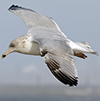 Herring Gull 9||P 1CY, 3CY & 4CY, October 2017 & 2019, February 2020, Scheveningen & Katwijk & Langevelderslag, the Netherlands.
Herring Gull 9||P 1CY, 3CY & 4CY, October 2017 & 2019, February 2020, Scheveningen & Katwijk & Langevelderslag, the Netherlands. Herring Gull (argenteus) 4.4 2CY & 5CY, October - December 2015 & February 2018, IJmuiden, Katwijk & Scheveningen, the Netherlands.
Herring Gull (argenteus) 4.4 2CY & 5CY, October - December 2015 & February 2018, IJmuiden, Katwijk & Scheveningen, the Netherlands. Herring
Gull 5W 4cy (argenteus), February 11 2010, Boulogne/Mer, France. Photo: J-M Sauvage.
Herring
Gull 5W 4cy (argenteus), February 11 2010, Boulogne/Mer, France. Photo: J-M Sauvage. Herring Gull (argenteus) 7K 2CY, February 02 2019, Scheveningen, the Netherlands.
Herring Gull (argenteus) 7K 2CY, February 02 2019, Scheveningen, the Netherlands. Herring Gull 9F 1CY & 4CY, November 2016 & February 2019, Katwijk, the Netherlands.
Herring Gull 9F 1CY & 4CY, November 2016 & February 2019, Katwijk, the Netherlands.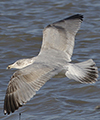 Herring Gull (argenteus) C8 1CY-4CY, December 2015 - February 2018, Scheveningen & Katwijk, the Netherlands.
Herring Gull (argenteus) C8 1CY-4CY, December 2015 - February 2018, Scheveningen & Katwijk, the Netherlands. 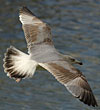 Herring Gull argenteus M8 4CY, February-March 2015, Rotterdam Zuid, the Netherlands. Picture: Merijn Loeve.
Herring Gull argenteus M8 4CY, February-March 2015, Rotterdam Zuid, the Netherlands. Picture: Merijn Loeve.  Herring Gull (argenteus) Y.BDS 1CY-5CY, September 2012 - April 2016, IJmuiden, the Netherlands. Pictures: Maarten van Kleinwee & Mars Muusse.
Herring Gull (argenteus) Y.BDS 1CY-5CY, September 2012 - April 2016, IJmuiden, the Netherlands. Pictures: Maarten van Kleinwee & Mars Muusse. Herring
Gull 5.325.398 4cy (argenteus), February 04 2002, IJmuiden, the
Netherlands (52.27N-04.33E). Ringed
July 02 1999, IJmuiden as pullus.
Herring
Gull 5.325.398 4cy (argenteus), February 04 2002, IJmuiden, the
Netherlands (52.27N-04.33E). Ringed
July 02 1999, IJmuiden as pullus. Herring Gull (argentatus) DEW N123586 4CY, February 27 2019, Katwijk, the Netherlands.
Herring Gull (argentatus) DEW N123586 4CY, February 27 2019, Katwijk, the Netherlands..jpg) Herring Gull (argentatus) J3861 4CY, February 09 2015, Hovindam - Oslo, Norway. Picture: John Sandøy.
Herring Gull (argentatus) J3861 4CY, February 09 2015, Hovindam - Oslo, Norway. Picture: John Sandøy. Herring Gull (argentatus) J5575 4CY, February 13 2015, Hovindam - Oslo, Norway. Picture: John Sandøy.
Herring Gull (argentatus) J5575 4CY, February 13 2015, Hovindam - Oslo, Norway. Picture: John Sandøy. Herring Gull (argentatus) J6785 2CY & 4CY, November 2014, February 2016 & November 2016, Katwijk & Terschelling, the Netherlands. Picture: Jacob Jan de Vries & Mars Muusse.
Herring Gull (argentatus) J6785 2CY & 4CY, November 2014, February 2016 & November 2016, Katwijk & Terschelling, the Netherlands. Picture: Jacob Jan de Vries & Mars Muusse..jpg) Herring Gull (argentatus) JAM11 4CY, February 21 2015, Hovindam - Oslo, Norway. Picture: John Sandøy.
Herring Gull (argentatus) JAM11 4CY, February 21 2015, Hovindam - Oslo, Norway. Picture: John Sandøy..
unringed sub-adult Herring Gull argentatus (on location)
.
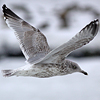 Herring
Gull argentatus 4CY, February 11 2010, Simrishamn, Sweden. Picture: Hans Larsson.
Herring
Gull argentatus 4CY, February 11 2010, Simrishamn, Sweden. Picture: Hans Larsson. Herring
Gull argentatus 4CY, February 24 2010, Simrishamn, Sweden. Picture: Hans Larsson.
Herring
Gull argentatus 4CY, February 24 2010, Simrishamn, Sweden. Picture: Hans Larsson.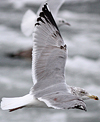 Herring
Gull argentatus sub-adult, February 24 2010, Simrishamn, Sweden. Picture: Hans Larsson.
Herring
Gull argentatus sub-adult, February 24 2010, Simrishamn, Sweden. Picture: Hans Larsson. Herring
Gull argentatus sub-adult, February 11 2010, Simrishamn, Sweden. Picture: Hans Larsson.
Herring
Gull argentatus sub-adult, February 11 2010, Simrishamn, Sweden. Picture: Hans Larsson. Herring
Gull sub-adult / 5cy, February 07 2013, Katwijk, the Netherlands.
Herring
Gull sub-adult / 5cy, February 07 2013, Katwijk, the Netherlands. Herring
Gull sub-adult / 5cy, February 07 2013, Katwijk, the Netherlands.
Herring
Gull sub-adult / 5cy, February 07 2013, Katwijk, the Netherlands. Herring
Gull sub-adult / 5cy, February 07 2013, Katwijk, the Netherlands.
Herring
Gull sub-adult / 5cy, February 07 2013, Katwijk, the Netherlands. Herring
Gull sub-adult / 5cy, February 07 2013, Katwijk, the Netherlands.
Herring
Gull sub-adult / 5cy, February 07 2013, Katwijk, the Netherlands. Herring
Gull sub-adult / 5cy, February 07 2013, Katwijk, the Netherlands.
Herring
Gull sub-adult / 5cy, February 07 2013, Katwijk, the Netherlands. Herring
Gull sub-adult / 5cy, February 27 2012, Noordwijk, the Netherlands.
Herring
Gull sub-adult / 5cy, February 27 2012, Noordwijk, the Netherlands. Herring
Gull sub-adult / 5cy, February 28 2012, Noordwijk, the Netherlands.
Herring
Gull sub-adult / 5cy, February 28 2012, Noordwijk, the Netherlands.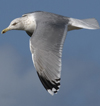 Herring Gull 5CY, February 21 2014, Katwijk, the Netherlands.
Herring Gull 5CY, February 21 2014, Katwijk, the Netherlands.  Herring Gull 5CY, February 21 2014, Katwijk, the Netherlands.
Herring Gull 5CY, February 21 2014, Katwijk, the Netherlands.  Herring
Gull sub-adult / 5cy, February 27 2012, Noordwijk, the Netherlands.
Herring
Gull sub-adult / 5cy, February 27 2012, Noordwijk, the Netherlands. Herring Gull 5CY, February 21 2014, Katwijk, the Netherlands.
Herring Gull 5CY, February 21 2014, Katwijk, the Netherlands.  Herring
Gull sub-adult / 5cy, February 28 2012, Noordwijk, the Netherlands.
Herring
Gull sub-adult / 5cy, February 28 2012, Noordwijk, the Netherlands. Herring
Gull sub-adult / 5cy, February 25 2012, Noordwijk, the Netherlands.
Herring
Gull sub-adult / 5cy, February 25 2012, Noordwijk, the Netherlands. Herring
Gull sub-adult / 5cy, February 25 2012, Noordwijk, the Netherlands.
Herring
Gull sub-adult / 5cy, February 25 2012, Noordwijk, the Netherlands. Herring
Gull sub-adult / 5cy, February 25 2012, Noordwijk, the Netherlands.
Herring
Gull sub-adult / 5cy, February 25 2012, Noordwijk, the Netherlands. Herring
Gull sub-adult / 5cy, February 07 2013, Katwijk, the Netherlands.
Herring
Gull sub-adult / 5cy, February 07 2013, Katwijk, the Netherlands. Herring
Gull sub-adult / 5cy, February 25 2012, Noordwijk, the Netherlands.
Herring
Gull sub-adult / 5cy, February 25 2012, Noordwijk, the Netherlands. Herring
Gull sub-adult / 5cy, February 07 2013, Katwijk, the Netherlands.
Herring
Gull sub-adult / 5cy, February 07 2013, Katwijk, the Netherlands. Herring
Gull sub-adult / 5cy, February 07 2013, Katwijk, the Netherlands.
Herring
Gull sub-adult / 5cy, February 07 2013, Katwijk, the Netherlands. Herring Gull 5CY, February 21 2014, Katwijk, the Netherlands.
Herring Gull 5CY, February 21 2014, Katwijk, the Netherlands.  Herring
Gull sub-adult / 5cy, February 07 2013, Katwijk, the Netherlands.
Herring
Gull sub-adult / 5cy, February 07 2013, Katwijk, the Netherlands. Herring Gull (argentatus) 5CY, February 18 2014, Katwijk, the Netherlands.
Herring Gull (argentatus) 5CY, February 18 2014, Katwijk, the Netherlands.  Herring
Gull 4cy, February 07 2013, Katwijk, the Netherlands.
Herring
Gull 4cy, February 07 2013, Katwijk, the Netherlands. Herring
Gull 4cy (argenteus), February 04 2002, IJmuiden, the
Netherlands (52.27N-04.33E).
Herring
Gull 4cy (argenteus), February 04 2002, IJmuiden, the
Netherlands (52.27N-04.33E). 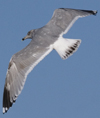 Herring Gull (argentatus) sub-adult, February 03 2014, Katwijk, the Netherlands.
Herring Gull (argentatus) sub-adult, February 03 2014, Katwijk, the Netherlands. 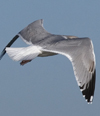 Herring Gull sub-adult , February 03 2014, Katwijk, the Netherlands.
Herring Gull sub-adult , February 03 2014, Katwijk, the Netherlands. unringed 4cy Herring Gulls
 Herring Gull 4CY, February 02 2018, Katwijk, the Netherlands.
Herring Gull 4CY, February 02 2018, Katwijk, the Netherlands.  Herring Gull 4CY, February 02 2018, Katwijk, the Netherlands.
Herring Gull 4CY, February 02 2018, Katwijk, the Netherlands.  Herring Gull 4CY, February 02 2018, Katwijk, the Netherlands.
Herring Gull 4CY, February 02 2018, Katwijk, the Netherlands.  Herring Gull 4CY, February 02 2018, Katwijk, the Netherlands.
Herring Gull 4CY, February 02 2018, Katwijk, the Netherlands.  Herring Gull 4CY, February 02 2018, Katwijk, the Netherlands.
Herring Gull 4CY, February 02 2018, Katwijk, the Netherlands.  Herring Gull sub-adult, February 02 2018, Katwijk, the Netherlands.
Herring Gull sub-adult, February 02 2018, Katwijk, the Netherlands.  Herring
Gull 4cy, February 07 2013, Katwijk, the Netherlands.
Herring
Gull 4cy, February 07 2013, Katwijk, the Netherlands. Herring
Gull 4cy, February 07 2013, Katwijk, the Netherlands.
Herring
Gull 4cy, February 07 2013, Katwijk, the Netherlands. Herring
Gull 4cy, February 07 2013, Katwijk, the Netherlands.
Herring
Gull 4cy, February 07 2013, Katwijk, the Netherlands. Herring
Gull 4cy, February 07 2013, Katwijk, the Netherlands.
Herring
Gull 4cy, February 07 2013, Katwijk, the Netherlands. Herring
Gull 4cy, February 07 2013, Katwijk, the Netherlands.
Herring
Gull 4cy, February 07 2013, Katwijk, the Netherlands.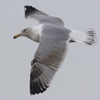 Herring
Gull 4cy, February 27 2012, Noordwijk, the Netherlands.
Herring
Gull 4cy, February 27 2012, Noordwijk, the Netherlands. Herring
Gull 4cy, February 27 2012, Noordwijk, the Netherlands.
Herring
Gull 4cy, February 27 2012, Noordwijk, the Netherlands. Herring
Gull 4cy, February 25 2012, Noordwijk, the Netherlands.
Herring
Gull 4cy, February 25 2012, Noordwijk, the Netherlands. Herring
Gull 4cy, February 25 2012, Noordwijk, the Netherlands.
Herring
Gull 4cy, February 25 2012, Noordwijk, the Netherlands.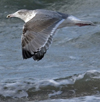 Herring Gull 4CY, February 21 2014, Katwijk, the Netherlands.
Herring Gull 4CY, February 21 2014, Katwijk, the Netherlands. Herring Gull 4CY, February 21 2014, Katwijk, the Netherlands.
Herring Gull 4CY, February 21 2014, Katwijk, the Netherlands. Herring Gull 4CY, February 21 2014, Katwijk, the Netherlands.
Herring Gull 4CY, February 21 2014, Katwijk, the Netherlands.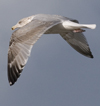 Herring Gull 4CY, February 21 2014, Katwijk, the Netherlands.
Herring Gull 4CY, February 21 2014, Katwijk, the Netherlands.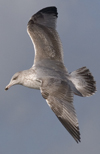 Herring Gull 4CY, February 21 2014, Katwijk, the Netherlands.
Herring Gull 4CY, February 21 2014, Katwijk, the Netherlands.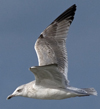 Herring Gull 4CY, February 21 2014, Katwijk, the Netherlands.
Herring Gull 4CY, February 21 2014, Katwijk, the Netherlands. Herring Gull 4CY, February 18 2014, Katwijk, the Netherlands.
Herring Gull 4CY, February 18 2014, Katwijk, the Netherlands. Herring Gull 4CY, February 18 2014, Katwijk, the Netherlands.
Herring Gull 4CY, February 18 2014, Katwijk, the Netherlands. Herring Gull 4CY, February 18 2014, Katwijk, the Netherlands.
Herring Gull 4CY, February 18 2014, Katwijk, the Netherlands. Herring Gull 4CY, February 18 2014, Katwijk, the Netherlands.
Herring Gull 4CY, February 18 2014, Katwijk, the Netherlands. Herring Gull 4CY, February 18 2014, Katwijk, the Netherlands.
Herring Gull 4CY, February 18 2014, Katwijk, the Netherlands. Herring Gull 4CY, February 18 2014, Katwijk, the Netherlands.
Herring Gull 4CY, February 18 2014, Katwijk, the Netherlands. Herring Gull 4CY, February 18 2014, Katwijk, the Netherlands.
Herring Gull 4CY, February 18 2014, Katwijk, the Netherlands. Herring Gull 4CY, February 18 2014, Katwijk, the Netherlands.
Herring Gull 4CY, February 18 2014, Katwijk, the Netherlands. Herring Gull 4CY, February 18 2014, Katwijk, the Netherlands.
Herring Gull 4CY, February 18 2014, Katwijk, the Netherlands. Herring Gull 4CY, February 18 2014, Katwijk, the Netherlands.
Herring Gull 4CY, February 18 2014, Katwijk, the Netherlands.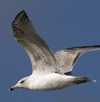 Herring Gull 4CY, February 21 2014, Katwijk, the Netherlands.
Herring Gull 4CY, February 21 2014, Katwijk, the Netherlands. Herring Gull 4CY, February 21 2014, Katwijk, the Netherlands.
Herring Gull 4CY, February 21 2014, Katwijk, the Netherlands. Herring
Gull 4cy, February 01 2012, Scheveningen, the Netherlands.
Herring
Gull 4cy, February 01 2012, Scheveningen, the Netherlands. Herring Gull 4CY, February 21 2014, Katwijk, the Netherlands.
Herring Gull 4CY, February 21 2014, Katwijk, the Netherlands. Herring Gull 4CY, February 21 2014, Katwijk, the Netherlands.
Herring Gull 4CY, February 21 2014, Katwijk, the Netherlands. Herring Gull 4CY, February 21 2014, Katwijk, the Netherlands.
Herring Gull 4CY, February 21 2014, Katwijk, the Netherlands.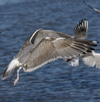 Herring Gull 4CY, February 03 2014, Katwijk, the Netherlands.
Herring Gull 4CY, February 03 2014, Katwijk, the Netherlands. Herring Gull 4CY, February 18 2014, Katwijk, the Netherlands.
Herring Gull 4CY, February 18 2014, Katwijk, the Netherlands. Herring Gull 4CY, February 21 2014, Katwijk, the Netherlands.
Herring Gull 4CY, February 21 2014, Katwijk, the Netherlands.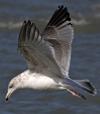 Herring Gull 4CY, February 21 2014, Katwijk, the Netherlands.
Herring Gull 4CY, February 21 2014, Katwijk, the Netherlands. Herring
Gull 4cy, February 28 2012, Noordwijk, the Netherlands.
Herring
Gull 4cy, February 28 2012, Noordwijk, the Netherlands.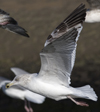 Herring
Gull 4cy, February 07 2013, Katwijk, the Netherlands.
Herring
Gull 4cy, February 07 2013, Katwijk, the Netherlands.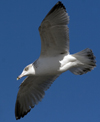 Herring
Gull 4cy, February 25 2012, Noordwijk, the Netherlands.
Herring
Gull 4cy, February 25 2012, Noordwijk, the Netherlands. Herring
Gull 4cy, February 27 2012, Noordwijk, the Netherlands.
Herring
Gull 4cy, February 27 2012, Noordwijk, the Netherlands. Herring
Gull 4cy, February 25 2012, Noordwijk, the Netherlands.
Herring
Gull 4cy, February 25 2012, Noordwijk, the Netherlands. Herring
Gull 4cy, February 25 2012, Noordwijk, the Netherlands.
Herring
Gull 4cy, February 25 2012, Noordwijk, the Netherlands. Herring
Gull 4cy, February 07 2013, Katwijk, the Netherlands.
Herring
Gull 4cy, February 07 2013, Katwijk, the Netherlands. Herring
Gull 4cy, February 27 2012, Noordwijk, the Netherlands.
Herring
Gull 4cy, February 27 2012, Noordwijk, the Netherlands. Herring
Gull 4cy, February 25 2012, Noordwijk, the Netherlands.
Herring
Gull 4cy, February 25 2012, Noordwijk, the Netherlands. Herring
Gull 4cy, February 25 2012, Noordwijk, the Netherlands.
Herring
Gull 4cy, February 25 2012, Noordwijk, the Netherlands. Herring Gull 4CY, February 21 2014, Katwijk, the Netherlands.
Herring Gull 4CY, February 21 2014, Katwijk, the Netherlands. Herring
Gull 4cy, February 25 2012, Noordwijk, the Netherlands.
Herring
Gull 4cy, February 25 2012, Noordwijk, the Netherlands. Herring
Gull 4cy, February 25 2012, Noordwijk, the Netherlands.
Herring
Gull 4cy, February 25 2012, Noordwijk, the Netherlands. Herring
Gull 4cy, February 25 2012, Noordwijk, the Netherlands.
Herring
Gull 4cy, February 25 2012, Noordwijk, the Netherlands. Herring
Gull 4cy, February 07 2013, Katwijk, the Netherlands.
Herring
Gull 4cy, February 07 2013, Katwijk, the Netherlands. Herring
Gull 4cy, February 25 2012, Noordwijk, the Netherlands.
Herring
Gull 4cy, February 25 2012, Noordwijk, the Netherlands. Herring Gull 4CY, February 03 2014, Katwijk, the Netherlands.
Herring Gull 4CY, February 03 2014, Katwijk, the Netherlands. Herring Gull 3rd cycle (4CY), February 03 2016, Terschelling, the Netherlands. Picture: Jacob-Jan de Vries.
Herring Gull 3rd cycle (4CY), February 03 2016, Terschelling, the Netherlands. Picture: Jacob-Jan de Vries. Herring Gull 4CY, February 18 2014, Katwijk, the Netherlands.
Herring Gull 4CY, February 18 2014, Katwijk, the Netherlands.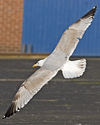 Herring Gull 4CY, February 19 2015, IJmuiden, the Netherlands.
Herring Gull 4CY, February 19 2015, IJmuiden, the Netherlands.  Herring Gull 4CY, February 19 2015, IJmuiden, the Netherlands.
Herring Gull 4CY, February 19 2015, IJmuiden, the Netherlands. 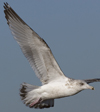 Herring Gull 4CY, February 03 2014, Katwijk, the Netherlands.
Herring Gull 4CY, February 03 2014, Katwijk, the Netherlands. Herring Gull sub-adult, February 03 2014, Katwijk, the Netherlands.
Herring Gull sub-adult, February 03 2014, Katwijk, the Netherlands. 
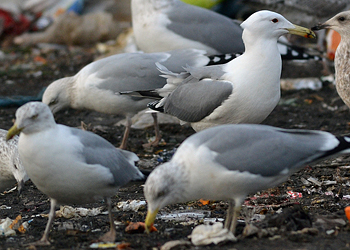
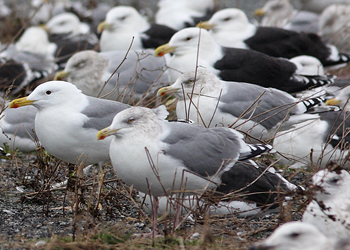
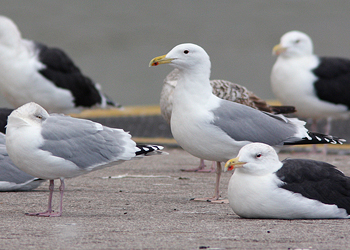
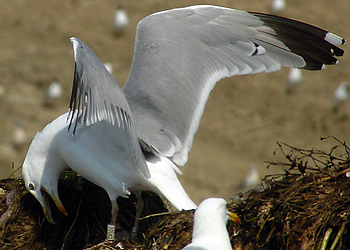

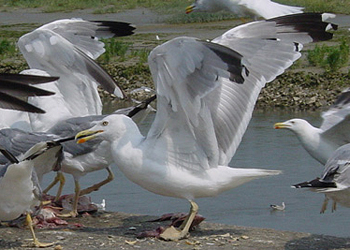
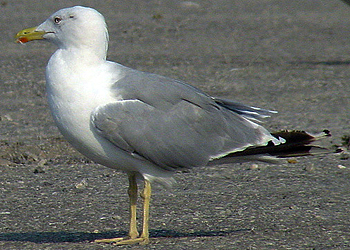
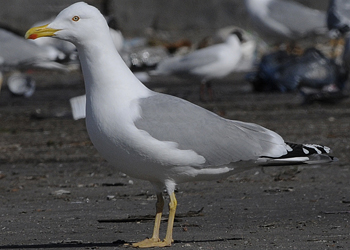

.jpg)
_Pet20(1).jpg)



